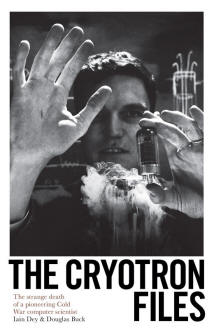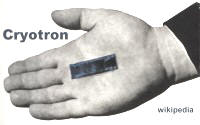Featured Product Archive
The inventions and products featured on these pages were chosen either for their
uniqueness in the RF engineering realm, or are simply awesome (or ridiculous) enough
to warrant an appearance.
| 1 |
2 |
3 |
4 |
5 |
6 |
7 |
8 |
9 |
10 |
11 |
12 |
13 |
14 |
15 |
16 |
17 |
18 |
19 |
20 |
21 |
<Previous
Next>

Longtime RF Cafe visitor, electrical engineer, and occasional contributor
Alan H. Dewey
sent me a note yesterday saying a book for which he helped provide a large amount
of research data has been published by authors
Iain Dey and Douglas
Buck. "The Cryotron Files: How the Inventor of the Microchip Put Himself
in the KGB's Sights," is an extensive delve into the background of
Dr. Dudley Allen
Buck, whose son, Douglas, conducted an extensive investigation into his father's
mysterious death that happened to coincide with the death of his father's colleague
and two other scientists just days after being visited by Soviet computer experts
(polonium
in his soup?). Dr. Buck was a superconductivity researcher during his short
(32 years), highly productive life. A
cryotron, BTW, is a superconducting
switch that would make for very low power supercomputers if it could be made practical
in integrated circuit (IC) form.
 Says Alan: "This story
was lived by very fascinating people. My function was to report the stories I have
learned; stories told by telegram, laboratory reports, M.I.T. notebooks, NSA travel
vouchers, and numerous interviews with colleagues, classmates and former students. Says Alan: "This story
was lived by very fascinating people. My function was to report the stories I have
learned; stories told by telegram, laboratory reports, M.I.T. notebooks, NSA travel
vouchers, and numerous interviews with colleagues, classmates and former students.
To those that have never been involved in historical research it might sound
to be a dull job. However each day I dug into boxes of documents brought new excitement
and renewal of ambition. I, like Dudley, started out as a licensed commercial broadcast
operator and a licensed amateur radio operator [W6WCK]. My
love of 'tinkering' with electronics and repair of antique electronics test equipment
prepared me to quickly develop a perspective of Dudley's experiments. Dudley's M.I.T.
laboratory notebooks are a time machine. I feel that I have spent time in those
laboratories in the 50's; I smelled the unique odor of hot vacuum tubes; I felt
 the ubiquitous gray wrinkle-finish paint;
I fell asleep with an oscilloscope probe in one hand, the other in a notebook, to
the sound of humming power supplies and throbbing vacuum pumps when transistors
were struggling to compete, when radios glowed in the dark and when mechanical engineers
were as necessary as electrical engineers to every product. the ubiquitous gray wrinkle-finish paint;
I fell asleep with an oscilloscope probe in one hand, the other in a notebook, to
the sound of humming power supplies and throbbing vacuum pumps when transistors
were struggling to compete, when radios glowed in the dark and when mechanical engineers
were as necessary as electrical engineers to every product.
Whilst indexing the files and documents at our disposal, amongst the files for
student theses supervised by Dudley Buck I discovered a file for Gordon J. Burrer.
Gordon, better known as Don, while a graduate student, was employed as a technician
in Dudley's laboratory. Could this be the same Don Burrer that I knew from my work
in infra-red imaging? A few emails confirm that this M.I.T. student was the same
man that helped found Inframetrics
[now FLIR Systems] and served on the board of directors of Laser Imaging Systems.
Don Burrer was extremely helpful finding many other students and colleagues which
helped tell this story.
 How long did it take to write this book?
There is no clear answer. Douglas Buck (Dudley's son) began the process of acquiring
documentation and locating acquaintances and colleagues decades ago. The real research
which generated this fascinating story was started decades before that; that research
conducted by one Dudley Allen Buck. How long did it take to write this book?
There is no clear answer. Douglas Buck (Dudley's son) began the process of acquiring
documentation and locating acquaintances and colleagues decades ago. The real research
which generated this fascinating story was started decades before that; that research
conducted by one Dudley Allen Buck.
It seems that I have been asked more than once in my life: "If you could travel
back in time and have dinner with one person, who would that be?" Before I began
this project I did not have an answer. Perhaps, after reading this book, we will
have to reserve a seat at Dudley's table for you.
This is not a story of the invention or development of computers; it is not a
story of the invention of magnetic core memory or the integrated circuit; it is
the story of a man who used his genius to develop inventors as well as inventions.
Looking back on these developments taking place fifty or more years ago, it seems
amazing that so many of his inventions and research projects continue to improve
our lives today. Whether it was luck or great thinking, it appears today that Dudley
knew what needed to be invented. Dudley helped many men become inventors, he helped
others become enormously wealthy. He did all of this by the age of 32.
Being an RF/Analog Electronics Engineer, I excel at producing technical documentation.
My fact-after-fact-after-fact summary of this history was forwarded to Iain Dey.
Iain skillfully turned my reference -book style of writing into a easy, interesting
read."
Note: Items in [square brackets] are my comments.
See also "Dudley
Buck's Forgotten Cryotron Computer," by David C. Brock, "The
Cryotron — A Superconductive Computer Component," MIT Lincoln Labs, the
DudleyBuck.com website, and mention of
"Don" Burrer in the MIT "Squaring the Blade" newsletter (p5).
Posted November 20, 2018
|



